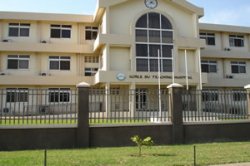The Korle Bu Teaching Hospital (KBTH) is to introduce a cost recovery levy as a means of ensuring the availability of resources for sustainability and efficient use.
The strategy will also put in place an effective preventive maintenance plan to ensure that equipment in the hospital do not break down prematurely.
Ms Sherry Ayittey announced this when she commissioned the hospital’s newly refurbished surgical theatre suites, child health babies unit and handed over of four ambulances to Korle Bu, Komfo Anokye and the Central Regional Teaching hospitals
“All the seven theatre suites, recovery ward, changing rooms and restrooms have been expanded and re-equipped.The ambulances are expected to replace old ambulances which have all broken down and also to enhance inter-departmental transfer of patients.This is part of the $67 million package that the Government of Ghana is investing in retooling the Hospital, under the National Equipment Replacement Project,” she revealed.
She said the measures were sum up in a Memorandum of Understanding between the Ministry and it agencies which would soon be discussed at a stakeholders’ forum where a policy dialogue on modalities of setting up a revolving fund for equipment maintenance in the health sector would be examined.
The replacement of old equipment with modern state of the art equipment, medical gas supply units and pre-installation works were carried out at a cost of $6,440,000.
The last medical equipment needs assessment carried out in 2010 revealed that not less than $2 billion was required over seven years up to 2017 to fully address the equipment gap.
Rev. Albert O. Botchway, acting Chief Executive Officer of the Korle Bu Teaching Hospital, said at the First Floor theatre suites were the busiest and had the highest number of theatres grouped together in one place which allowed the synergistic use of skilled labour, equipment and other resources.
“The commissioning of the theatre suites, which also marks the final handing over of the Unit to the Hospital, will greatly enhance surgical operations and our activities generally” he said and added that the backlog of surgical cases could be cleared
He said other Departments also deserved commendation because they had to share their theatre space with Staff of the Surgical Sub-Budget Management Centre (BMC) when cases had to be rescheduled and alternative arrangement made with Gynecologic and Pediatric Surgical theatres in order to ensure that work did not grind to a halt as a result of the ongoing project.
The recovery ward has been fitted with six beds with gas pipelines which have their own stands for the placement of monitors while the rest rooms and changing rooms have also been expanded and provided with the necessary items to give workers and patients a congenial atmosphere for work.
With the refurbishment the Sub-BMC is rolling out a microsurgical procedure known as Bariatric Surgery which would give patients who will need surgical intervention as treatment for overweight and obesity.
This procedure will enable surgeons to surgically reduce the storage capacity of the stomach of patients as a way of regulating their food intake, thus, helping them to control their weight.
The procedure enables patients to eat whatever they like without the usual dietary constraints. He explained that the rehabilitation of the Babies Unit and the heavy infusion of new equipment into the ward through the Ministry’s retooling project increase the unit costs from 47 to 54, one to nine incubators and nine ventilation support machines and infusion devices.
Prof. Clegg Lamptey, Head of Surgical Sub BMC, expressed his delight for the turn-around of the theatres saying the former was very unsuitable.
He appealed to the Minister to support the Department to create a conducive out-patient area for clients of the centre to which the minister pledged the ministry’s support.
Prof Bamenla Goka, Head of the Child health BMC, welcome said last year 5,904 children were detained with a mortality rate of children under five with 22-26 percent twice the children admitted to the wards.
Forty percent of EW occurred within 24 hours of admission while 86 percent occurred within 72 hours and that many of the children would have survived if the intensive care facilities were available.
She therefore called completion of the new emergency, paediatric intensive care and sub-specialty building for the Department, which due to lack of funding, had halted
Health News of Wednesday, 2 April 2014
Source: GNA
Korle Bu to introduce cost recovery levy

















